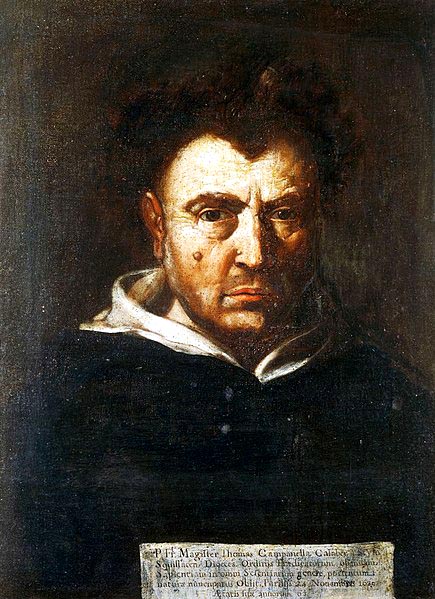 |
| Tommaso Campanella (Wikipedia) |
Note: Tommaso Campanella was a freethinker and ahead of his time--which caused him no end of trouble with the Roman Catholic Church!
Get Ready: What would be a "utopian society" in your mind?
Tommaso Campanella (1568-1639) was not just a contemporary of Galileo, but was in fact his defender. Born Giovanni Domenico Campanella, he became a monk at age 15 and took the name Brother Thomas after his hero, the 13th-century theologian Thomas Aquinas.
Tommaso was a child prodigy who challenged the ideas of his teachers. In his mid-twenties he published his first book, which rejected the ideas of Aristotle shared by most people of the time.
He also began to study astrology and other practices that went against the teachings of the Church. For this and his rejection of Aristotle he, like Galileo, was placed under house arrest until 1597.
Once free, he began a movement against the Spanish who were occupying his hometown at the time. He tried to establish a utopian community in preparation for the year 1600, a time when many thought that a new era in the history of the world would come.
This got him arrested again, and this time he was tortured nearly to death. He remained in prison for 27 years, during which time he wrote his most important works.
One of these was The Defense of Galileo (see Lesson #04-010), written when that scientist was first tried in 1616, though Tommaso's defense was not published until 1622.
His most famous work, though, was called The City of the Sun. It was written in Italian in 1602, but first published in Latin in 1623.
Like the works of Plato, the book is in the form of a dialogue, and like that philosopher's Republic, it explores the idea of a "perfect society," or utopia. In this society, men would share their goods, and families would be mingled together. All work, no matter how skilled or unskilled, would be of equal value. Only indolence would be looked down on.
One of the most interesting ideas in The City of the Sun was that the walls of the city would be painted with all human knowledge, so that everyone had access to this information. Among these images, Tommaso placed Jesus Christ in with other teachers and gods: the Jewish Moses, Egyptian Osiris, Greco-Roman Jove and Mercury, and the Muslim prophet Muhammad.
Tommaso remained in a Spanish prison until 1626, and was held in Rome until 1629. However, trouble arose again five years after he was freed, and he went to France, where he was supported by the French king until his death.
--------
Read more: https://en.wikipedia.org/wiki/Tommaso_Campanella
Practice: Match the term to its definition below:
- astrology
- child prodigy
- indolence
- mingled
- monk
- prophet
- rejection
- theologian
- tortured
- unskilled
- a person who writes about God
- laziness
- a person who takes vows and joins a religious group
- not having any special ability
- mixed together
- one who speaks on behalf of God
- a young person with extraordinary talent
- opposite of "acceptance"; disbelief in
- questioned using violence
- the idea that the stars tell our future
Answers are in the first comment below.
Submitted to the Shenzhen Daily for April 28, 2015


Answers to the Practice: 1. j; 2. g; 3. b; 4. e; 5. c; 6. f; 7. h; 8. a; 9. i; 10. d
ReplyDelete